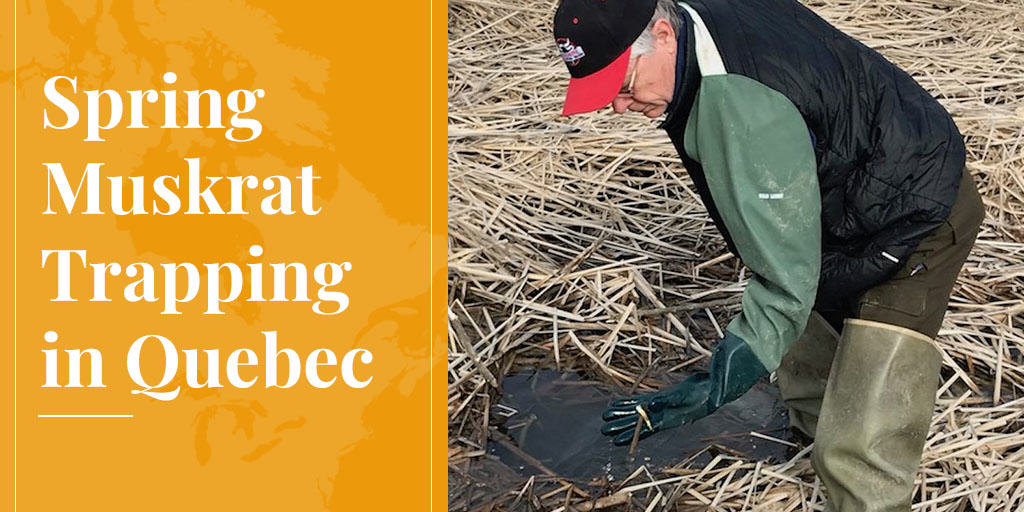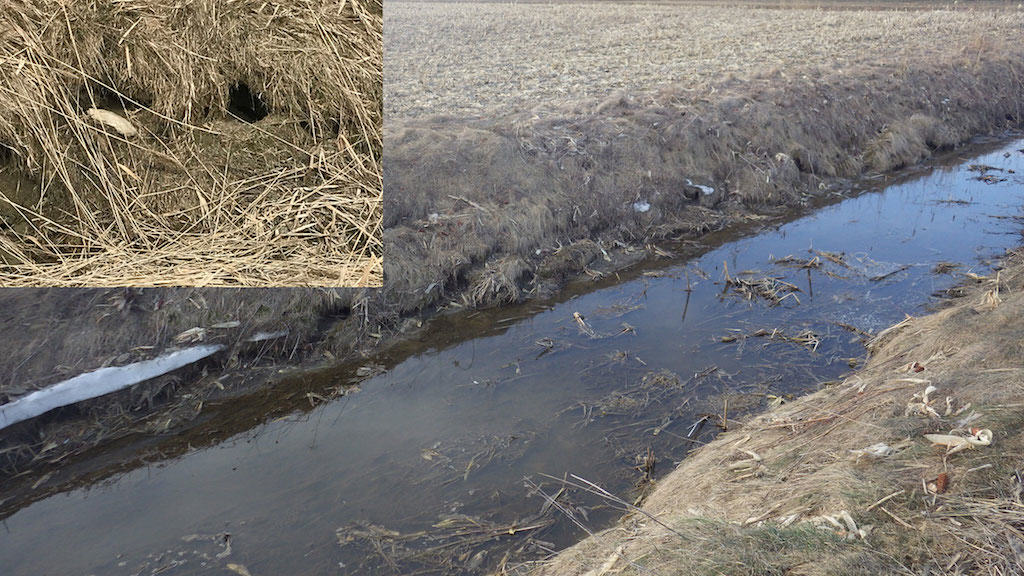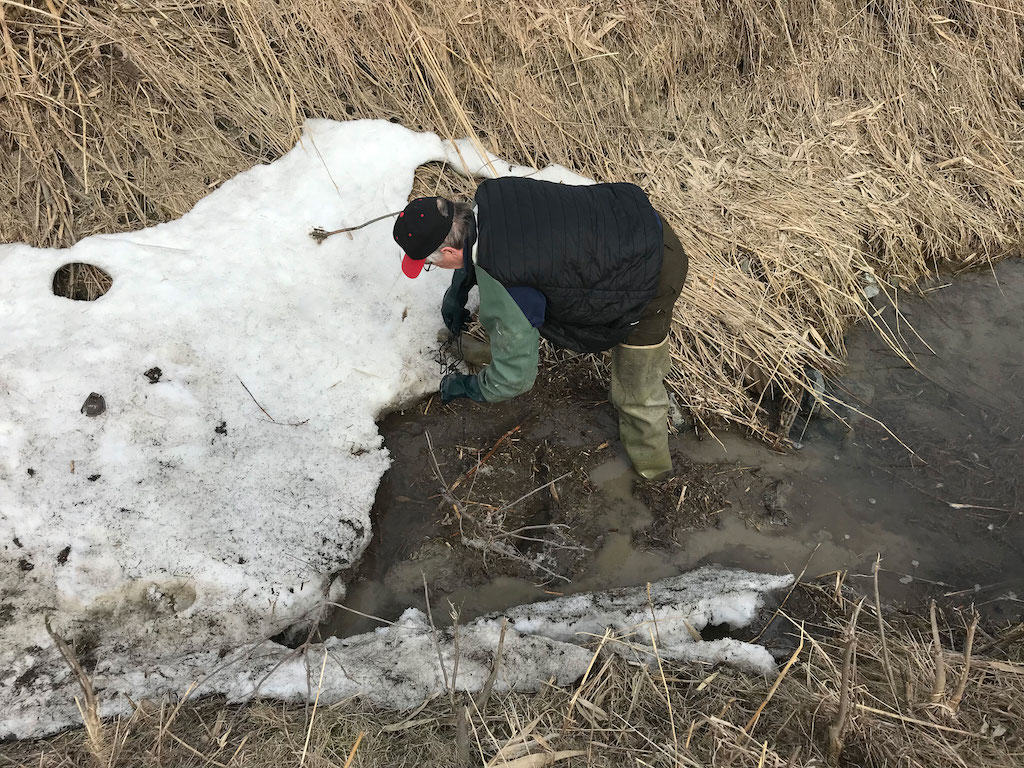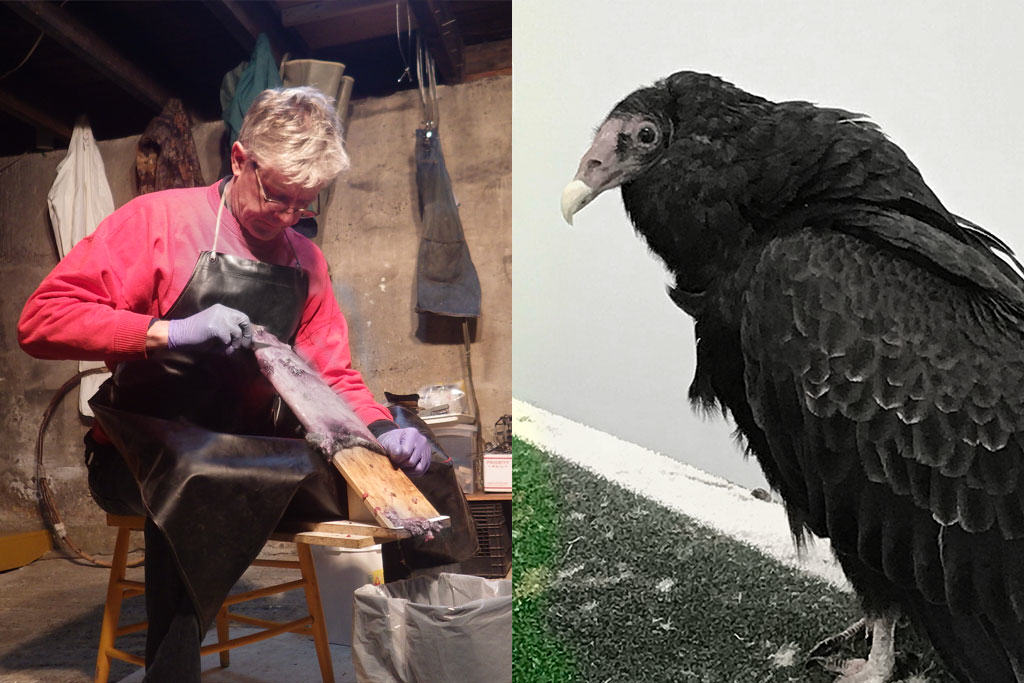
It was a crisp, bright morning in early April when I set out for my first lesson in Spring muskrat trapping. I had agreed to meet my trapper friend in the village of Saint-Charles, on the Richelieu River, about a half-hour north-east of Montreal. A plaque in front of the small town hall recounted the role of this picturesque spot during the 1837 rebellion by French Canadian “Patriotes”, including their defeat here by British troops on November 25 of that year.
Pierre arrived a few minutes later and I threw my gear into the back of his mud-splattered truck, beside a large white plastic bucket of traps and another containing several muskrats he had taken earlier that morning. As we headed out of the village and away from the river, houses quickly gave way to large fields and the occasional barn. On each side of the road were wide drainage ditches, with a foot or two of Spring melt water running swiftly through a few remaining patches of snow and last summer’s dry, flattened rushes – prime muskrat habitat.

Pierre was driving slowly and then he stopped, pointing out a tiny flash of orange tape, a marker he had left, barely visible in the dry weeds beside the gravel road. He climbed out of the truck and clambered down the embankment in his hip waders, and I watched as he felt about in the weedy stream. A moment later he straightened up to display a sleek, wet muskrat in his rubber-gloved hand. He then showed me how the rotating-jaw trap had struck directly behind the rodent’s skull, killing it instantly – much like a large mousetrap.
Pierre was using two models of quick-killing trap, both tested and certified for use under provisions of the Agreement on International Humane Trapping Standards (AIHTS). And who better to demonstrate the efficient performance of these devices than my friend Pierre Canac-Marquis, the long-time coordinator of the Fur Institute of Canada’s humane trap research and development program? He has always considered animal welfare concerns as a top priority in all trapping activity.
SEE ALSO: Fur Institute of Canada champions humane and sustainable fur production.

Pierre had recently retired from his career as a furbearer biologist with the Quebec wildlife department where, among other notable achievements, he led “Operation Raton”, a multi-year, multi-million-dollar program to contain the advance of rabies in raccoons spreading north from the US – an important story to be told in another blog post. But he continues to coordinate the FIC’s world-leading trap-research program, and he remains an avid trapper.
“It’s a passion,” Pierre explained. “It’s certainly not for the money; I’ll be lucky to get four dollars a pelt for these rats. But the farmers are happy we’re here, because muskrats undermine the stream banks with their burrows. That speeds erosion and they lose large strips of farm land along the drainage ditches,” he said, pointing out a large burrow entrance, half-hidden among dry reeds in the stream bank. This of course represents a major loss of income to these farmers.
“And over there, they raise horses,” said Pierre. “If a horse steps onto a part of the field that has been burrowed by the muskrats, they can sink right through and break a leg.”
And muskrats – like all rats – are very prolific.
Muskrats (Ondatra zibethicus)

With a gestation period of 28-30 days, and females sexually mature at six to eight weeks, muskrats can breed year-round, producing five or six litters annually in the southern US. In Canada, they usually produce two or three litters of six to nine kits. Natural mortality is also high, and research has shown that harvest rates of 60-75% are sustainable. Primarily herbivores, muskrats eat the shoots, roots, bulbs and leaves of all sorts of aquatic plant, but cattails, also called bulrushes, are favoured. They will also eat some crops (carrots, corn, alfalfa, soybeans) and sometimes clams, mussels and small fish.
Weighing 2-3 pounds (1-1.4 kg), and measuring 16-24 inches (40-65 cm) in length, muskrats (Ondatra zibethicus, as biologists know them) have large, yellowish teeth and long, naked tails. More interesting from a fur-trade perspective: muskrats have very dense, waterproof underfur covered by long, glossy-brown guard hairs, to protect them in their semi-aquatic environment. Because of its warmth, abundance, and relatively low cost, muskrat fur was very popular through much of the 20th century. Often it was sheared and dyed to imitate more expensive furs, and sometimes marketed under more glamorous names like “Hudson Seal”. Today, muskrat is still a popular fur to make warm and lightweight winter hats, notably for the Canadian Mounties (RCMP) and other police forces.
“Once, I had parked my truck by the side of one of these country roads and when I climbed back up the embankment there were two Quebec Provincial Police officers waiting for me,” said Pierre. “They didn’t recognize my vehicle and were wondering what this suspicious guy was doing down there. I pointed to their heads and explained that I was harvesting fur for their new hats! They were fascinated. Like most people, they had never thought where their fur hats came from.”
We spent the next few hours navigating the back roads, checking traps. Pierre had added a modern twist to this traditional art: many of the trap locations had been punched into his GPS, making them much easier to find. Sometimes the traps were empty, but more often we added to the collection in the back of Pierre’s truck.

When we completed his round, we swung by St-Charles-sur-Richelieu again to pick up my car, and I followed Pierre for one last stop, 20 kilometers away at a raptor rehabilitation clinic in the town of St-Hyacinthe. The clinic is supported by the University of Montreal’s Faculty of Veterinary Medicine, and the Quebec Union for the Rehabilitation of Raptors. Injured birds of prey are sent here from all over the province and beyond. The clinic also has the educational objective of assisting in the training of hundreds of veterinarians in the field of wildlife medicine and wild bird rehabilitation.
The technicians at the raptor clinic were pleased to see Pierre, but their feathered charges were more interested in the contents of the big sack he carried from the truck: carcasses from muskrats Pierre had skinned the previous days.
SEE ALSO: Top 5 tasty furbearers: Muskrat stew and more.
After a quick tour of some of the magnificent raptors being cared for in the facility, I said “bye” to Pierre and headed back down the highway to Montreal.
As Pierre said, the dozen muskrats we’d collected that morning wouldn’t bring him more than $50 at the next auction – not much for the time spent setting traps, checking them, skinning muskrats, and stretching and drying the pelts. But more important, he’d helped with the rehabilitation of some magnificent birds, and assisted some farmers and ranchers in protecting their land and animals, contributing to the “joie de vivre” of this heritage rural community.
Not bad for a morning’s work, all in all!










